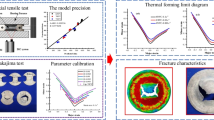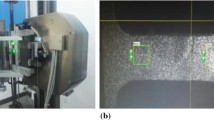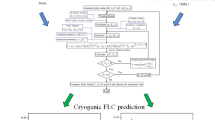Abstract
Alloy 2060, a new generation of aluminum–lithium (Al-Li) alloy, is widely used for aviation structural parts due to its high-specific strength and high-specific stiffness. However, poor formability of Al-Li alloy is commonly exhibited at room temperature. In this paper, the formability of Al-Li alloy 2060 was studied under the conditions of elevated temperatures. The Marciniak–Kuczynski (M–K) model was developed to effectively predict the forming limit curves (FLCs) under hot stamping conditions. Firstly, the hot tensile test was conducted to investigate the high-temperature deformation behaviors, and the Fields–Backofen equation was calibrated to represent the flow stress of the alloy. Then, the isothermal hemispherical punch tests were proposed to obtain the FLCs of Al-Li alloy 2060. Finally, the FLC predicted by the M–K model was input into the deep drawing finite element simulation model to verify the accuracy of the prediction results and predict the possible fracture of the hot stamping parts. The cup-shaped deep drawing test and the thin-walled shell part hot stamping test were carried out to verify the accuracy of the FLCs and the formability of the Al-Li alloy 2060. The results show that the true stress increases with the strain rate increasing and decreases with the temperature increasing. The established M–K model can accurately predict the FLCs of alloy 2060. It is also found that the initial thickness imperfection factor f0 is an important parameter that determines the change of FLC. Comparing the experimental and simulation results, it is concluded that the established M–K model would be adaptable in the FE simulation to estimate if the fracture of parts occurs. The simulation model considered the FLC can predict the fracture, thinning, and wrinkle of the parts. The stamping depth increases with the deformation temperature increasing and the blank holder force decreasing.






















Similar content being viewed by others
References
Qin H, Zhang H, Wu H (2015) The evolution of precipitation and microstructure in friction stir welded 2195–T8 Al–Li alloy. Mater Sci Eng, A 626:322–329
Rioja RJ, Liu J (2012) The evolution of Al-Li base products for aerospace and space applications. Metall and Mater Trans A 43(9):3325–3337
Dursun T, Soutis C (2014) Recent developments in advanced aircraft aluminium alloys. Mater Design (1980–2015) 56:862–871
De PS, Mishra RS, Baumann JA (2011) Characterization of high cycle fatigue behavior of a new generation aluminum lithium alloy. Acta Mater 59(15):5946–5960
Zhang X, Yang W, Xiao R (2015) Microstructure and mechanical properties of laser beam welded Al–Li alloy 2060 with Al–Mg filler wire. Mater Des 88:446–450
Gao H, Weng T, Liu J, Li C, Li ZQ, Wang LL (2016) Hot stamping of an Al-Li alloy: a feasibility study. Manuf Rev 3:9
Hao M, Wang L, Chen JZ, Lei Y, Li GA (2021) In-plane anisotropy and tensile failure mechanism of 2060–T8E30 Al-Li alloy sheet. Rare Met 45(6):641–649
Garrett RP, Lin J, Dean TA (2005) An investigation of the effects of solution heat treatment on mechanical properties for AA 6xxx alloys: experimentation and modelling. Int J Plast 21(8):1640–1657
Liu HJ, Hu YY, Dou C, Dusan PS (2017) An effect of the rotation speed on microstructure and mechanical properties of the friction stir welded 2060–T8 Al-Li alloy. Mater Charact 123:9–19
Peng JW, Li WD, Wan M, Zhang CS, Li J, Sun GG (2018) Investigation on three-roller cylindrical bending of 2060–T8 Al-Li alloy plate for aircraft fuselage skin components. IntJ Mater Form 11(2):269–278
Ou L, Zheng ZQ, Nie YF, Jian HG (2015) Hot deformation behavior of 2060 alloy. J Alloy Compd 648:681–689
Yang XM, Wang BY, Zhou J, Dang LM, Xiao WC, Wang YQ (2020) Influence of process parameters on deep drawing of 2060 Al–Li alloy under hot stamping process. Int J Light Mater Manuf 3(1):36–42
Fan XB (2016) Law and strengthening mechanism of heat deformation-quenching composite forming of 2195 Al-Li alloy plates. Harbin, Harbin Institute of Technology
Li XQ, Song N, Guo GQ, Sun ZG (2013) Prediction of forming limit curve (FLC) for Al–Li alloy 2198–T3 sheet using different yield functions. Chin J Aeronaut 26(5):1317–1323
Yang XM, Wang BY, Xiao WC (2018) Prediction of forming limit curve of 6016 aluminum alloy based on MK theory. Chin J Eng 40(4):485–491
Bressan JD, Bruschi S, Ghiotti A (2016) Prediction of limit strains in hot forming of aluminium alloy sheets. Int J Mech Sci 115:702–710
Jain M, Allin J, Lloyd DJ (1999) Fracture limit prediction using ductile fracture criteria for forming of an automotive aluminum sheet. Int J Mech Sci 41(10):1273–1288
Ma GS, Wan M, Wu XD (2008) Theoretical prediction of FLDs for Al-Li alloy at elevated temperature based on MK model. Chin J Nonferrous Metals 18:980–984
Yang XY, Lang LH, Liu KN, Cai GC, Guo C (2015) Prediction of forming limit diagram of AA7075-O aluminum alloy sheet based on modified MK model. J Beijing Univ Aeronaut Astronaut 41(4):675
Abovyan T, Kridli GT, Friedman PA, Ayoub G (2015) Formability prediction of aluminum sheet alloys under isothermal forming conditions. J Manuf Process 20:406–413
Lin JG, Mohamed M, Balint D, Dean TA (2014) The development of continuum damage mechanics-based theories for predicting forming limit diagrams for hot stamping applications. Int J Damage Mech 23(5):684–701
Xiao WC, Wang BY, Zheng KL (2017) An experimental and numerical investigation on the formability of AA7075 sheet in hot stamping condition. Int J Adv Manuf Technol 92(9):3299–3309
Gao HX, El Omer F, Wang LL, Denis JP, Li ZQ (2017) Forming limit prediction for hot stamping processes featuring non-isothermal and complex loading conditions. Int J Mech Sci 131:792–810
Cheng YQ, Zhang H, Chen ZH, Xian KF (2008) Flow stress equation of AZ31 magnesium alloy sheet during warm tensile deformation. J Mater Process Technol 208(1–3):29–34
Zhang YG, Li ZQ, Wang YQ, Li H, Li SH (2021) Determination of interfacial heat transfer coefficient in cold hot forming of 2060 Al-Li alloy: experiment and algorithm. Acta Aeronaut et Astronaut Sinca 42(2):423805
Funding
This work is funded by the National Natural Science Foundation of China (Grant No. 51705018). This work is supported by the Fundamental Research Funds for the Central Universities (Grant No. FRF-BD-20-08A, FRF-BD-19-003A).
Author information
Authors and Affiliations
Contributions
Jing Zhou: investigation, validation, methodology, funding acquisition, writing—original draft. Xiaoming Yang: software, investigation, writing—reviewing and editing. Baoyu Wang: supervision, resources. Jiapeng Wang: investigation, writing—reviewing and editing.
Corresponding author
Ethics declarations
Ethics approval
The article follows the guidelines of the Committee on Publication Ethics (COPE) and involves no studies on human or animal subjects.
Consent to participate
Applicable.
Consent to publish
Applicable.
Conflict of interest
The authors declare no competing interests.
Additional information
Publisher's note
Springer Nature remains neutral with regard to jurisdictional claims in published maps and institutional affiliations.
Rights and permissions
Springer Nature or its licensor (e.g. a society or other partner) holds exclusive rights to this article under a publishing agreement with the author(s) or other rightsholder(s); author self-archiving of the accepted manuscript version of this article is solely governed by the terms of such publishing agreement and applicable law.
About this article
Cite this article
Zhou, J., Yang, X., Wang, B. et al. M–K model based forming limit prediction of aluminum–lithium alloy 2060 and its application in hot stamping. Int J Adv Manuf Technol 127, 5293–5306 (2023). https://doi.org/10.1007/s00170-023-11898-w
Received:
Accepted:
Published:
Issue Date:
DOI: https://doi.org/10.1007/s00170-023-11898-w




